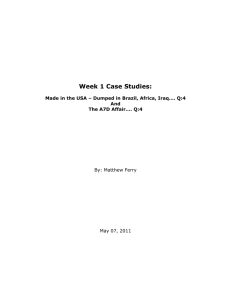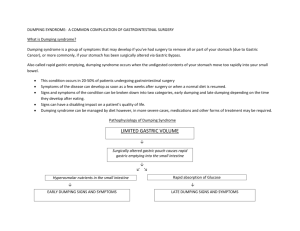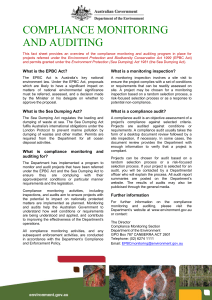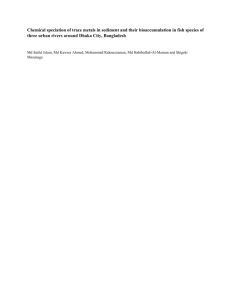Objectives of the Chapter
advertisement
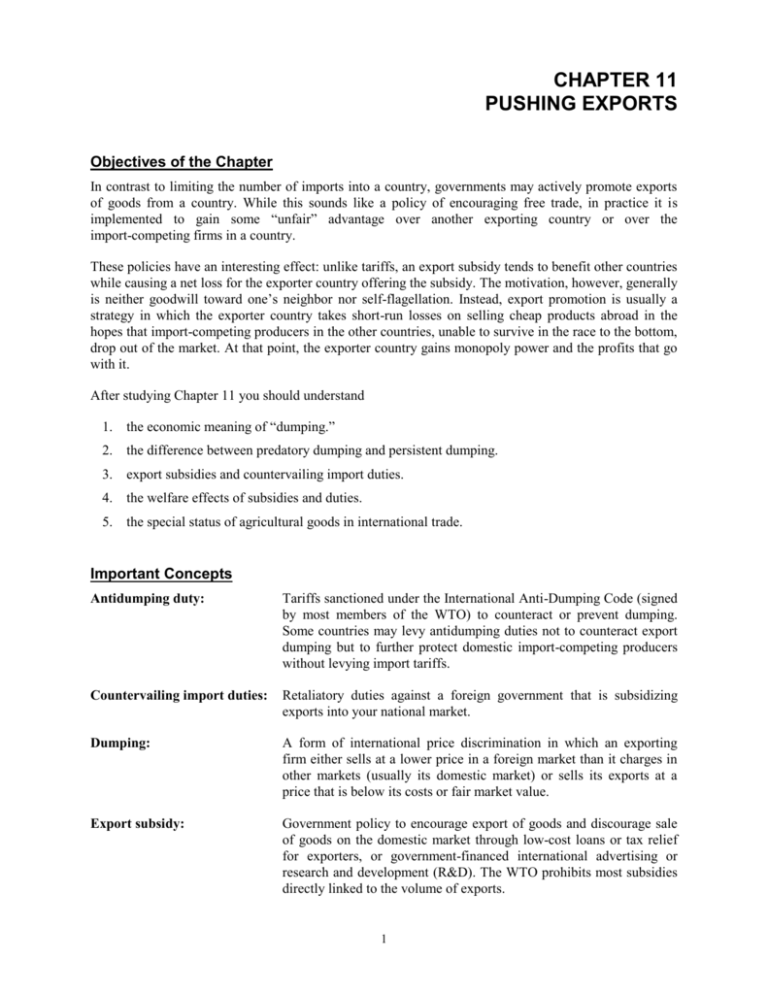
CHAPTER 11 PUSHING EXPORTS Objectives of the Chapter In contrast to limiting the number of imports into a country, governments may actively promote exports of goods from a country. While this sounds like a policy of encouraging free trade, in practice it is implemented to gain some “unfair” advantage over another exporting country or over the import-competing firms in a country. These policies have an interesting effect: unlike tariffs, an export subsidy tends to benefit other countries while causing a net loss for the exporter country offering the subsidy. The motivation, however, generally is neither goodwill toward one’s neighbor nor self-flagellation. Instead, export promotion is usually a strategy in which the exporter country takes short-run losses on selling cheap products abroad in the hopes that import-competing producers in the other countries, unable to survive in the race to the bottom, drop out of the market. At that point, the exporter country gains monopoly power and the profits that go with it. After studying Chapter 11 you should understand 1. the economic meaning of “dumping.” 2. the difference between predatory dumping and persistent dumping. 3. export subsidies and countervailing import duties. 4. the welfare effects of subsidies and duties. 5. the special status of agricultural goods in international trade. Important Concepts Antidumping duty: Tariffs sanctioned under the International Anti-Dumping Code (signed by most members of the WTO) to counteract or prevent dumping. Some countries may levy antidumping duties not to counteract export dumping but to further protect domestic import-competing producers without levying import tariffs. Countervailing import duties: Retaliatory duties against a foreign government that is subsidizing exports into your national market. Dumping: A form of international price discrimination in which an exporting firm either sells at a lower price in a foreign market than it charges in other markets (usually its domestic market) or sells its exports at a price that is below its costs or fair market value. Export subsidy: Government policy to encourage export of goods and discourage sale of goods on the domestic market through low-cost loans or tax relief for exporters, or government-financed international advertising or research and development (R&D). The WTO prohibits most subsidies directly linked to the volume of exports. 1 Persistent dumping: Dumping that goes on indefinitely, as opposed to predatory dumping or “cyclical dumping,” which occurs only during periods of economic downturn. It is used by firms that can price-discriminate between markets. Predatory dumping: Dumping that occurs when an exporting firm temporarily reduces the price charged to some foreign buyers with the intent of eliminating competitors and later raising its price after the competition is dead. Safeguard policy: Temporary protection against a sudden surge of imported goods. Strategic trade policy: A government campaign to develop export advantage in targeted sectors or to gain market share in global industries characterized by oligopolies. Warm-up Questions True or False? Explain. 1. T/F An export subsidy is more common than an export duty. 2. T/F Although it discourages most tariffs, the WTO allows an importing country to levy antidumping tariffs. 3. T/F Strategic trade policy and predatory dumping are weapons of economic warfare. 4. T/F China is the world’s leading steel exporter. 5. T/F If a country levies a countervailing duty against a subsidized exporter, trade volumes and prices end up being about the same as those that would exist without the subsidy and duty. Multiple Choice 1. Which of the following is a correct statement? A. Dumping is a money-losing venture for any firm. Therefore, it can only be a temporary phenomenon. B. Firms engage in dumping for the sole purpose of driving competition out of the market in order to later raise prices. C. Dumping is only possible when a firm can discriminate between markets. Otherwise, the dumpee can re-export the dumped goods at a profit. D. Dumping is always a profitable venture. Otherwise, no one would ever engage in dumping. 2 2. In 1970, a major dumping case was brought against Sony of Japan. Sony was selling televisions made in Japan to U.S. consumers for $180 while charging Japanese consumers $333 for the same model. In response to the threat issued by the U.S. government, Sony shifted its supply for the U.S. market to a plant built in California, but did not change prices of televisions in either country. This case best describes A. protection by the U.S. government of Japanese producers and consumers. B. persistent dumping. C. predatory dumping. D. trade retaliation. 3. If a foreign government is subsidizing exports into your national market, what should you do to maximize the net welfare effect on your nation (assuming there is no monopsony power)? A. Enjoy the bargain prices for imports. B. Retaliate by imposing a countervailing duty to protect the domestic industry. C. Subsidize your own exports to foreign markets. D. Retaliate by imposing an import quota. 4. For profitable persistent dumping to take place, A. demand elasticities in both markets must be the same. B. demand in both markets must be inelastic. C. demand in both markets must be elastic. D. demand in the foreign market must be more elastic than the demand in the home market. 5. Agricultural price supports A. may require a country to limit imports of agricultural products. B. may result in surplus domestic production being dumped on world markets. C. may turn an importer of agricultural products into an exporter of those products. D. all of the above. Problems 1. Suppose that Leinster subsidizes exports of telephones to Saxony by paying exporters a “bounty” of one loaf of bread for each telephone exported. How would that affect the level of welfare in Leinster and in Saxony? 3 2. Continuing with the export subsidy on Leinster’s telephones: a. Given that welfare in Saxony actually increases as a result of Leinster’s export subsidy for telephones, why might the Saxon government retaliate against these inexpensive imports? b. Given that welfare in Leinster decreases as a result of its export subsidy, why would Leinster implement such a subsidy? c. If Saxony levies a countervailing duty on telephone imports of exactly one loaf of bread per telephone, how will this affect Saxon, Leinsterian, and world welfare? 3. Which of the following television-exporting countries is guilty of dumping in the Saudi Arabian market? Average unit cost Domestic price in exporting country Export price from factory Price in Saudi Arabia Philips (Holland) $250 Sharp (Japan) $300 RCA (U.S.) $295 $250 $325 $300 $200 $310 $300 $260 $350 $350 4 4. Suppose Hibernia is a country with a single domestic producer of steel, Rigid Inc. Rigid Inc. can sell as much steel as it wishes at home, where demand is relatively inelastic, or to the rest of the world (where there are many other steel suppliers). Show how such a situation may lead Rigid Inc. to dump its steel on the world market. 5. On a brief break from school, you decide to go lie on some remote South American beach, where you run into the Trade Minister for Venezuela. Having exhausted the topics of beer and soccer, he asks you to outline for him the likely costs and benefits of eliminating the country’s $2 per pound export subsidy on coffee beans. He gives you some information by drawing Figures 11.5a and 11.5b in the sand at your feet. Using this information, dazzle him with your answer. Figure 11.5a Figure 11.5b 5 6. As a result of massive street marches by Leinsterian bakers, the Prime Minister has decided to set a “fair” price for bread at 0.75 telephones/loaf. a. What will be the effect of this support price on bread production in Leinster and on international trade in bread? b. What will be the effect of this support price on welfare in Leinster? Discussion Topics 1. Try to formulate arguments for export subsidies in terms of the national defense and the infant industry models. 2. What sectors (if any) do you think are likely to be the objects of strategic trade policy of the U.S. government in the future? 6

